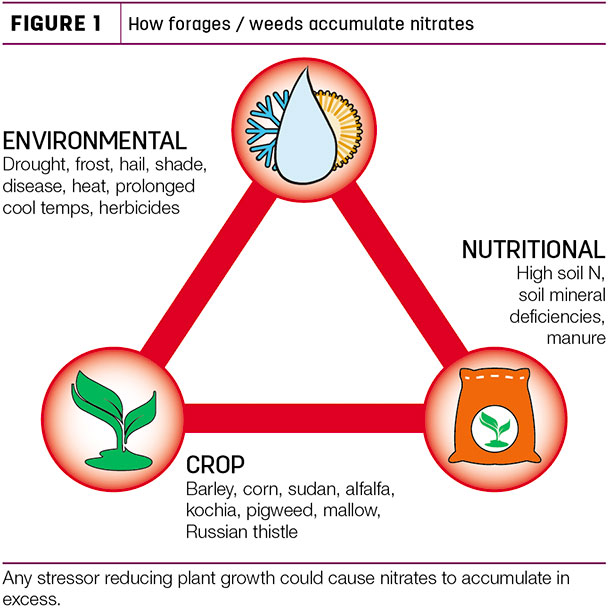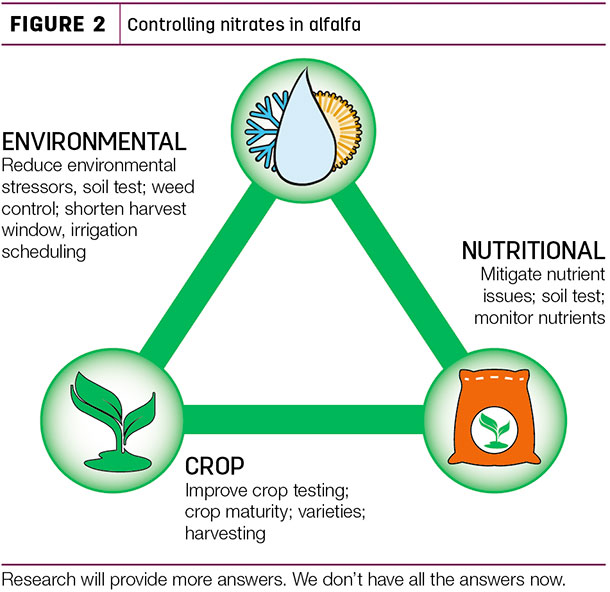Excess nitrate accumulation in alfalfa is complex; thus potential solutions will require comprehensive and integrated approaches. The literature provides excellent guidelines for feeding or utilization of high-nitrate hay, but the solutions to mitigate the production problem are fewer and pretty disjointed.
Crop nitrate information in the literature is more easily summarized as a triangle response to environmental, crop and nutritional inputs or influences (Figure 1).

Ag folks know of “oat hay poisoning” stories from long ago. Other plants known to accumulate nitrates include but are not limited to: most grasses, small grains, corn, sorghum, sudangrass; weeds such as kochia, common mallow, redroot pigweed, Russian thistle. Oats, barley, corn and sorghum-sudan grasses also accumulate nitrates in the stems, with less in the leaves and very little in the seed.
Nitrate accumulation in alfalfa
Alfalfa accumulates nitrates in the leaves rather than the stems. Alfalfa grows from the top up, so will continually add yield at the top apical meristem with each new internode stem and leaf tissue. At the bud stage, when most growers wish to harvest alfalfa for high-quality hay, leaves represent about 50 percent (the range is usually 47 to 53 percent) of the dry plant weight.
This puts alfalfa growers in a dilemma, since leaves accumulate nitrates, and bud stage is when the crop produces the greatest amount of leaves.
Soil nutrients influence nitrate accumulation. Recognized long ago, high soil nitrogen is a negative contributing factor in crop nitrate accumulation. We recommend testing alfalfa hay fields every year if problems have occurred in the past, if plants exhibit nutrient deficiency symptoms or if production is lagging.
Soil testing will provide guidance as to the current nutrient status for pH, organic matter, macronutrients and micronutrients. A complete soil test should be viewed as part of the farm’s insurance policy. Soil pH controls solubility of nutrients needed for sustained alfalfa growth.
Soil pH varies widely in the alfalfa hay-growing region and is best determined by the soil test. If the soil test report shows high-nitrate, high-ammonium or high-organic nitrogen, this is the first red flag.
Alfalfa fixes its own nitrogen, but compost, manure or other nitrogen sources may increase soil concentrations beyond crop needs. If the soil test shows low phosphorus, potassium, calcium, magnesium, sulfur or boron, that is another red flag.
Deficiency of these elements will slow alfalfa growth, which can lead to nitrate accumulation. For example, if soil phosphorus is low and pH is high, then crop growth will be stunted, internodes will be shorter, but leaves will still be produced – and nitrates will accumulate.
Environmental influences and irrigation
Environmental influences may or may not be controlled by producers. Factors we cannot control include frost or hail events, which damage the apical meristem and stunt the plants, thus contributing to nitrate accumulation. Cool temperatures and shading have often been implicated in nitrate accumulation due to reduced plant growth.
Alfalfa is one of the model crops used for irrigation scheduling, since it uses a lot of water and does not control transpiration as much as other crops. Soils vary in water-holding capacity, with sandy soils retaining the least amount and clay soils the most.
What type of soil is your alfalfa growing in, and what does the bank account of water to draw from look like? With more coarsely textured soils, such as sandy soils, things will dry faster, so we must increase the speed of farming practices and get water back quickly after harvest.
Drought has strongly been implicated, with many alfalfa growers irrigating, but hay may still have high nitrates. Irrigation systems are highly engineered today but may not provide the amount of water needed to keep alfalfa actively growing and reduce forage nitrates.
There are two problems associated with water management in alfalfa: First, we may not be applying enough irrigation water to maintain growth rate of alfalfa during the hot, dry summers. Visual assessment may not be good enough to determine if alfalfa is water-stressed when temperatures exceed 95ºF with a breeze or wind. Stratified soil water monitoring may help.
Second, when harvesting alfalfa, fields are often left to dry out a week or more before baling and bale removal. After harvest is complete, irrigation water is reapplied, but this may have spanned from 10 days to two weeks since the last irrigation. Our former colleague, Steve Orloff (University of California – Davis at Yreka, now deceased), commented some growers took three weeks before irrigation water would be returned to alfalfa after harvest.
Alfalfa is a deep-rooted crop but falls behind early in soil water retention, then compounds lower soil moisture through a normal season with multiple cuttings and intense summer heat, which increases the odds of excess forage nitrate.
We need to shorten the harvest time period and return irrigation water back sooner so plant growth returns to normal. Infiltration rates limit how fast we can put water back on fields using center pivots or linear irrigation without ponding and runoff. Methods to increase wetted surface area and reduce evaporation losses, such as low-energy precision application, could help.
Coupling low soil moisture with an imbalance of soil nutrients and compounding that with summer heat stress, the crop experiences a short but significant drought event, and it will respond to that event.
Review irrigation application schedules to maintain soil water to keep alfalfa actively growing and reduce forage nitrate. In the hot summer months, when alfalfa growth is reduced, then nitrates can accumulate even when yields are perceived as adequate.
Herbicides can compound the problem
Herbicides have been shown to cause plants to accumulate nitrates. The classic example is 2,4-D, which is not applied to alfalfa. But we do apply other modes of herbicide action to alfalfa that inhibit plant photosynthesis and could alter growth, thereby influencing nitrate accumulation. Review all the herbicides to control weeds, ask questions and determine if this could be a factor.
Management guidelines
We certainly don’t have all the answers to preventing nitrate accumulation in alfalfa hay crops. However, we can suggest (Figure 2) the following management guidelines:

1. Soil test all or past problem fields.
2. Test all cuttings for nitrates along with normal forage quality analyses.
3. Manage soil pH and mitigate soil nutrient issues.
4. Harvest hay as quickly as possible.
5. Monitor soil moisture and avoid drought events or periods without irrigation by performing preventative maintenance on your irrigation system.
6. Evaluate weed control practices.
In summary, nitrate accumulation in alfalfa is a complex problem without a single silver-bullet solution. Reducing crop growth through increased stressors and imbalances in the soil and environment increases the likelihood for forage nitrates. Test, monitor, interpret and develop planned changes based on the best information available. Good luck in 2018. ![]()
Steve Norberg is a forage extension agronomist with Washington State University in Pasco. Email Steve Norberg.
Steve Fransen is a forage extension agronomist with Washington State University in Pasco. Email Steve Fransen.










